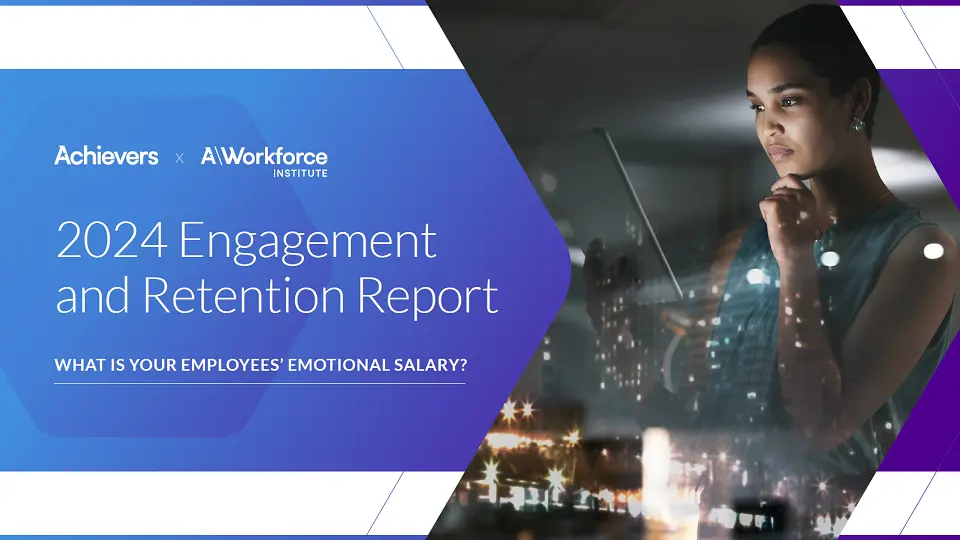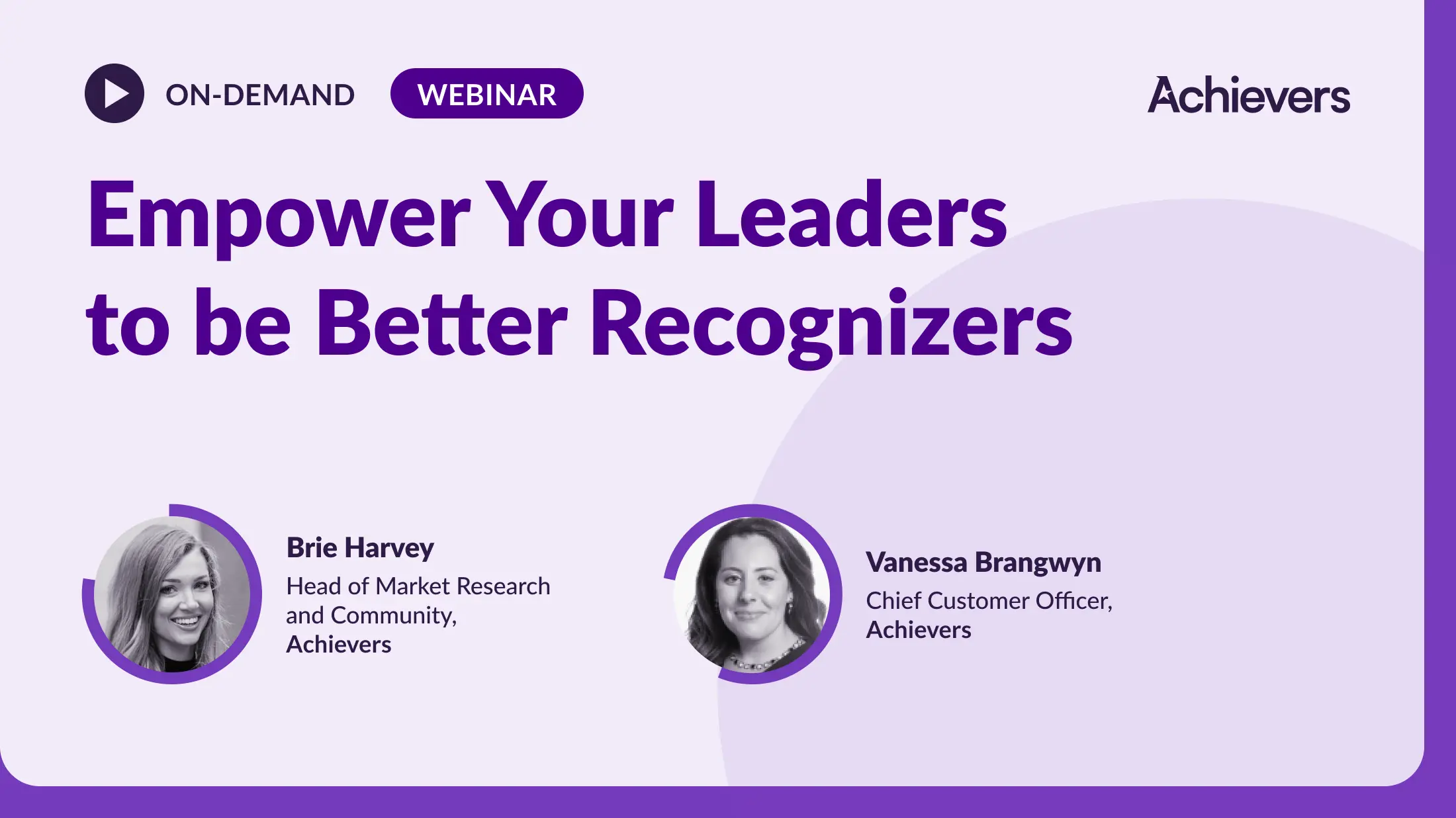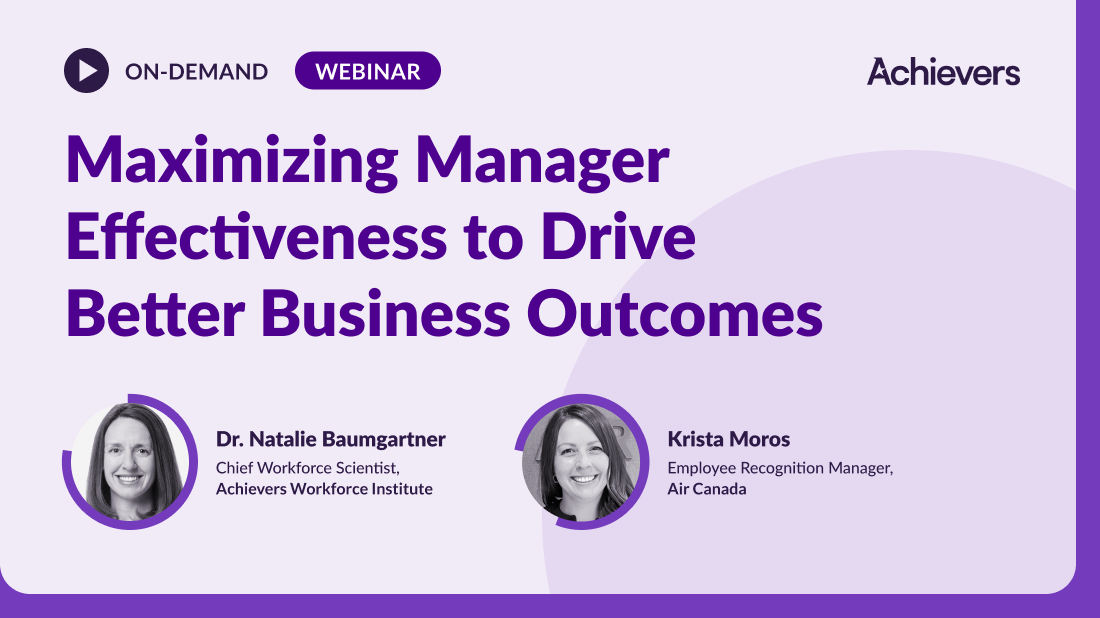Create a culture that means business™
Email address
A competitive salary is no longer enough to attract and retain the best talent. With the advent of remote work and organizations’ ever-increasing need for skilled, experienced workers, individuals have more choice, flexibility, and leverage when job hunting than ever before. If you want to successfully attract the workers your company needs time and time again, offer them something your competitors can’t: a best-in-class employee experience.
Employee experience encompasses all the interactions an employee has with your organization, from their first interview forward. Building a great employee experience demands a holistic effort touching on everything from showing appreciation to employees, to providing them with opportunities for upward mobility, to simply helping them feel like they truly belong. And bringing these disparate pieces together is what employee experience management is all about.
What is employee experience management?
Employee experience management is the practice of making every aspect of an individual’s employment as positive and fulfilling as positive. At its core, the goal of employee experience management is to create an organizational culture that prioritizes employee wellbeing, satisfaction, and engagement. By addressing the needs and expectations of employees, companies can foster a sense of belonging and loyalty among their workforce. This in turn leads to higher levels of employee retention and performance, contributing to sustained organizational success.
Employee experience management requires gathering and analyzing data on your workforce to develop a deep, real-time picture of their needs, motivations, and challenges. Based on these insights, HR professionals, company leadership, and other stakeholders must work together to take concrete steps to address the parts of the employee experience that are falling short. They should also recognize that employee experience management isn’t a one-and-done practice, continuing to collect feedback and adjusting their efforts to create the best employee experience possible.
Why is employee experience management important?
Employee experience management can positively impact your organization in multiple ways, starting with improved employee engagement. Engaged employees are committed to their work and consistently give their all, displaying consistent and contagious enthusiasm about contributing to the company’s success. A stellar employee experience encourages team members to take a genuine interest and joy in their work, keeping them motivated no matter what difficulties come their way.
Employee experience management also benefits talent retention and recruitment efforts. A reputation for a great employee experience helps differentiate your company from other employers, making it more attractive to prospective hires and current employees alike. This helps your organization recruit employees with the expertise and personality traits needed to succeed while reducing the costs of turnover and preserving institutional knowledge.
What is the role of an employee experience manager?
Large organizations should consider appointing a dedicated employee experience manager to spearhead relevant initiatives. These HR professionals develop and implement strategies aimed at enhancing team members’ experience during every stage of the employee lifecycle, from recruitment to offboarding. They collect and analyze employee feedback, design programs to address the issues this feedback reveals, and then measure the impact of these initiatives as they go live.
To excel in this role, an employee experience manager should possess strong communication and interpersonal skills to effectively engage and empathize with employees at all levels of the organization. Proficiency in data analysis and project management is also a must for assessing and quickly acting on employee feedback. And a background in human resources, industrial and organizational (I/O) psychology, or a related field is a plus as well.
How to improve employee experience management
Tackling employee experience management might seem like a daunting task, but as with most things in life, taking it step by step — with the help of an actionable guide — makes the process much simpler. Let’s dive into five winning strategies for improving the employee experience at your company.
1. Ask your employees how you can improve their experience
Every workforce has different needs and preferences, which is why improving employee experience management starts with soliciting feedback directly from employees. By listening to employee feedback and acting upon it, organizations can dedicate their limited resources to areas where they’ll have the greatest effect. Involving employees in decision-making processes also benefits employee empowerment while fostering a culture of transparency and trust.
Pulse surveys, in-person feedback sessions, and AI-powered chatbots are just some of the tools available for gathering employee input confidentially. Beyond these formal feedback channels, train managers on how to practice transparent communication between themselves and their direct reports. Fostering relationships built on mutual trust will help employees feel more confident that leaders want to hear what they really think — and that they’ll take meaningful action based on their input.
2. Prioritize employee recognition and rewards
Recognition is the top driver of engagement, which is one of the biggest parts of a great employee experience — and organizational success more broadly. Disengaged workers have 37% higher absenteeism, 49% more accidents, and 60% more errors than their engaged counterparts. But turning recognition into a core part of your organizational culture requires more than the occasional call out during a meeting or message of thanks in chat. Without an employee recognition platform that gives team members a centralized place to show gratitude, they’ll lack enough opportunities — and incentives — to provide recognition frequently enough to make a real impact.
Your company doesn’t need to build its program from scratch, though. Instead, rely on an employee recognition and rewards platform backed by years of expertise and research. The best solutions make providing social recognition easy and fun whether your workforce is remote, in-person, or hybrid. And they let team members back their words of appreciation with reward points the recipients can redeem for merchandise and experiences in a built-in catalog that features millions of options. Look for a solution with a high adoption rate and a track record of success, and your company’s culture of recognition will be off to a strong start.
3. Foster a culture of flexibility and work-life balance
In our new normal, employees place even more value on ability to balance their professional responsibilities with personal obligations and interests. Offering work arrangements that facilitate this, like remote and hybrid work options, flexible scheduling, and compressed workweeks, is one of the fastest ways to improve the employee experience. Your organization should also consider providing resources that support work-life balance, such as wellness programs, child care assistance, and mindfulness training.
Building a culture that values work-life balance requires leaders to buy in and serve as examples for other team members. Leaders and managers should encourage employees to prioritize their own wellbeing and set clear, reasonable expectations regarding workload, deadlines, and boundaries. This fosters open communication, helps prevent burnout, and contributes to a healthy work environment.
4. Invest in employee development and growth opportunities
Employees are more likely to feel engaged and satisfied in their roles when they have opportunities for learning and career advancement. Your company can invest in its workforce by providing access to online learning materials and in-office training programs. It can even offer access to off-site educational opportunities and encourage continued formal education by offering full or partial tuition reimbursement. Enhance the impact of your talent development program by personalizing learning plans to match individual interests, relative strengths, and career goals.
To ensure that the new skills your employees learn don’t go to waste, build career paths that make advancement a real possibility regardless of a team member’s role. Clearly communicating the advancement options available to employees and what they need to do to progress makes it easy for team members to envision a long-term future with your organization, fostering loyalty and motivation. Managers should also act as coaches who try to empower employees and help them achieve their professional goals and address weaknesses constructively.
5. Make employees feel like they belong
If employees don’t feel comfortable being their true selves at your organization, none of your efforts to improve their experience will go very far. That’s why fostering a diverse and inclusive workplace culture is so important. Embracing real diversity goes beyond checking off boxes to creating an environment where all employees feel valued, respected, and empowered to be themselves. Organizations should hire employees that bring a multitude of experiences and perspectives to the table, provide diversity training, and establish inclusive employee resource groups to support underrepresented individuals. Leaders also play a critical role in modeling inclusive behaviors by actively listening to diverse viewpoints, addressing biases and microaggressions, and championing diversity initiatives.
Using employee experience management solutions
Employee experience management platforms serve as a centralized hub for all of your company’s employee experience initiatives. When selecting an employee experience management solution, look for a that integrates with the tools your employees use every day, as well as your organization’s existing HR systems. This facilitates quick adoption by your workforce and helps get your employee experience initiatives off to a strong start.
Your company should choose a platform that takes a holistic approach to employee experience management, from gathering employee input, to improving communication, to enabling recognition. Ensure it includes feedback channels that are customizable and easy to use — like pulse surveys — along with always-on feedback channels that are available any time team members have a thought they want to share. And prioritize a solution with both social recognition capabilities and a built-in, wide-ranging rewards marketplace all employees can use.
Start building an exceptional employee experience
If you’re looking for a single platform to manage every part of the employee experience, you’ve found it in the Achievers Employee Experience Platform. Its built-in recognition solution, Achievers Recognize, has the highest active usage and adoption rate — 93% — in the industry. And Achievers users are 3.6x more likely to show appreciation multiple times per month compared to its competitors. It’s backed by a rewards marketplace with over 3 million options from 2,500 global brands. And the Achievers Experience Platform also provides your people leaders with the information they need to tailor the employee experience to match the needs and preferences of your workforce, thanks to the feedback tools and analytics features of Achievers Listen.
See how Achievers can improve employee experience management at your company today with a free demo.






